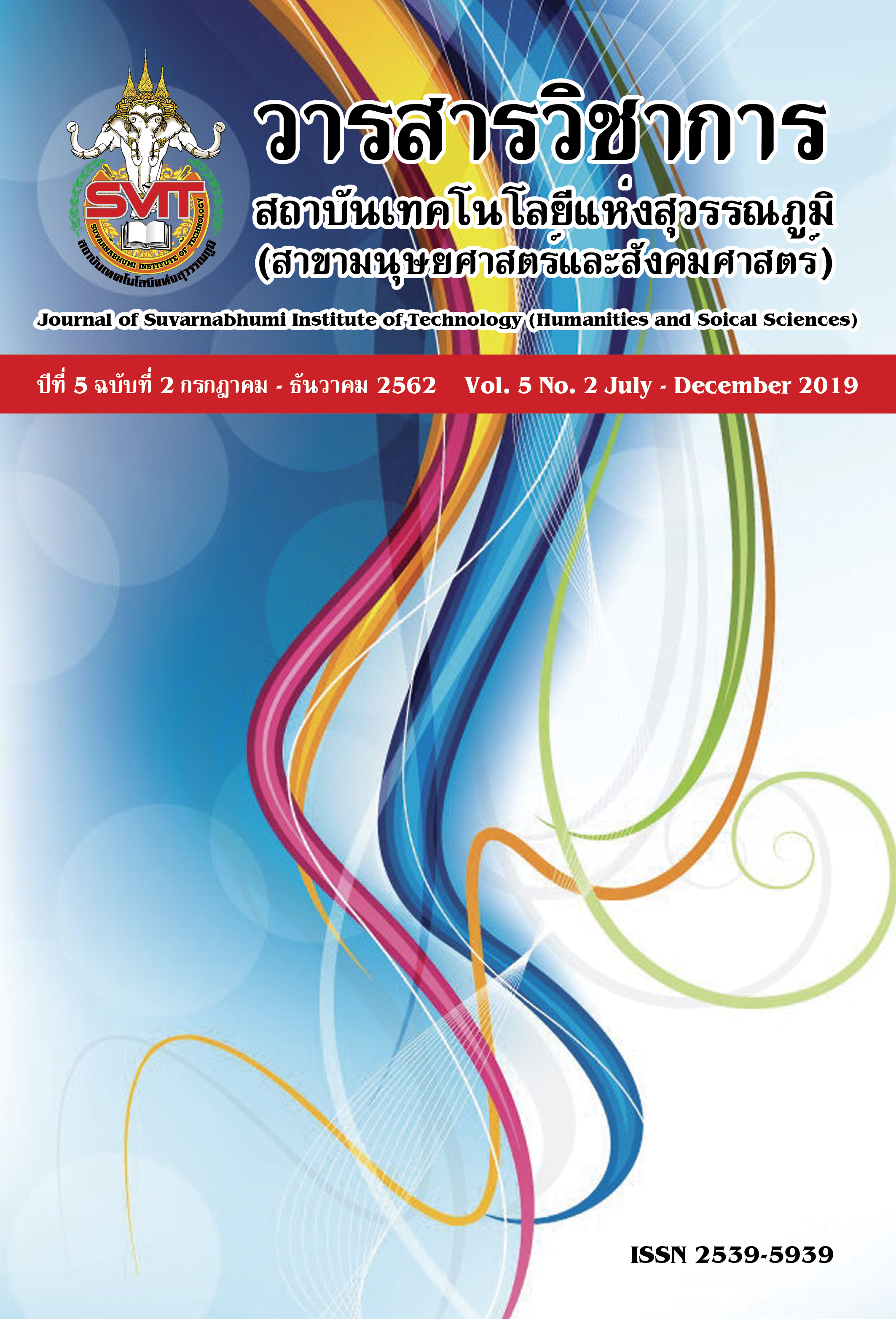THE STUDY OF ORGANIZATIONAL COMMUNICATION BEHAVIOR IN DAXIN COMPANY (THAILAND) LIMITED
Keywords:
species, communication behavior, communication componentsAbstract
The purposes of this research were to (1) study communication behavior of the businessmen of Daxin co., ltd. (Thailand) (2) study the communication’s components of business men of Daxin co., ltd. (Thailand) (3) compare communication behavior and components as classified by gender, age, education level,and business position. The research samples were 390 businessmen of Daxin co., ltd. (Thailand). Data collection instrument was the five- levels rating scale questionnaire, concerning, communication behavior and components within the organization. Data analysis was proceeded using frequency, percentage, mean, and standard deviation. The statistics, t-test and One-way ANOVA were used to test research hypotheses. The outcome can be summarized as follows;
The business men of Daxin co., ltd. (Thailand), had horizontal communication behavior 3 types include, downward communication behavior and upward communication behavior at a high level, respectively. The businessmen of Daxin co., ltd. (Thailand), had communication components 4 aspects including, such as, receiver, sender, and channel, at a high level. While they had communication components, regarding, message was at the highest level.
The comparison of communication behaviors among businessmen of Daxin co., ltd. (Thailand) .Whose genders, ages, education levels , and business positions, were different, can be summarized as follows; the businessmen whose gender were different, had significant differences in upward communication behavior, at a .05 significant level. Whereas, no significant difference were found in downward and horizontal communication. The businessmen whose ages were different, had significant differences in downward and upward communication behavior. at a .05 significant level. However, no significant difference were found in horizontal communication. The businessmen whose education levels were different, had significant differences in upward communication behavior at a .05 significant level. Whereas, no significant difference were found in downward and horizontal communication. The businessmen whose business positions were different, had significant differences in downward communication, upward communication, and horizontal communication behavior at a .05 significant level. Whereas, no significant difference were found in horizontal communication.
The comparison of communication components among businessmen of Daxin co., ltd. (Thailand) .Whose genders, ages, education levels, and business positions, were different, and can be summarized as follows; The businessmen whose genders were different, had significant differences in the communication compositions at a .05 significant level. These were sender and receiver. Whereas, no significant difference were found in message and channel. The businessmen whose ages were different, had significant differences in the communication compositions at a .05 significant level, such as, message and channel. Whereas, no significant difference were found in sender and receiver. The businessmen whose education levels were different, had significant differences in the communication compositions at a .05 significant level, such as, sender receiver and channel. Whereas, no significant difference were found in message. The businessmen whose business positions were different, had significant differences in the communication compositions at a .05 significant level, such as, sender, receiver, message, and channel.
References
ชญานิษฐ์ สุขเกษม. (2551). สัมฤทธิผลของรูปแบบการสื่อสารภายในองค์กรของบริษัท เพน พับลิชชิ่ง จำกัด. วิทยานิพนธ์วารสารศาสตรมหาบัณฑิต มหาวิทยาลัยธรรมศาสตร์.
บุญใจ ศรีสถิตนรากูร. (2555). การพัฒนาและตรวจสอบคุณภาพเครื่องมือวิจัย:คุณสมบัติการวัดเชิงจิตวิทยา. กรุงเทพฯ: โรงพิมพ์แห่งจุฬาลงกรณ์มหาวิทยาลัย.
พัธรา นักรา. (2550). กลยุทธ์การสื่อสารที่ใช้ในการบริหารการเปลี่ยนแปลงของธนาคารไทยพาณิชย์ จากัด (มหาชน). วิทยานิพนธ์ปริญญานิเทศศาสตรมหาบัณฑิต. จุฬาลงกรณ์ มหาวิทยาลัย.
ยุพาพร ทองอินทร์. (2555). ความคิดเห็นเกี่ยวกับบรรยากาศการสื่อสารภายในองค์กรของพนักงานโรงแรมโมเวนฟิค รีสอร์ท แอนด์สปา กะรนบีชภูเก็ต. วิทยานิพนธ์ศิลปศาสตรมหาบัณฑิต, มหาวิทยาลัยศิลปากร.
รสชงพร โกมลเสวิน. (2558). ทฤษฎีและพฤติกรรมการสื่อสาร หน่วยงานที่ 8-15 (เอกสารประกอบการสอน). กรุงเทพฯ : สำนักพิมพ์มหาวิทยาลัยสุโขทัยธรรมาธิราช
วรวงษ์ เอี่ยมสำอาง. (2557). การศึกษารูปแบบการติดต่อสื่อสาร ภายในและภายนอกองค์กร ที่ส่งผลต่อประสิทธิผลในการทำงานของพนักงานระดับปฏิบัติการในเขตกรุงเทพมหานคร. การศึกษาอิสระบริหารธุรกิจมหาบัณฑิต มหาวิทยาลัยกรุงเทพ.
วิเชียร วิทยอุดม. (2550). องค์การและการจัดการ. กรุงเทพฯ: ธนธัชการพิมพ์.
วิรัช สงวนวงศ์วาน. (2550). การจัดการและพฤติกรรมองค์การ . กรุงเทพฯ :ซีเอ็ดยูเคชั่น.
ศศิพงษ์ ศรีสวัสดิ์.(2559). การพูดเพื่อการสื่อสาร. อุดรธานี: โรงพิมพ์บ้านเหล่าการพิมพ์.
สิน พันธุ์พินิจ. (2551). เทคนิคการวิจัยทางสังคมศาสตร์. พิมพ์ครั้งที่ 3. กรุงเทพฯ: วิทยพัฒน์
สุรพงษ์ โสธนะเสถียร และวัลลีย์ ศรีประภาภรณ์. (2550). โครงการหลักและแนวทางการบริหารการสื่อสาร : มิติทั้งสามในด้านการสื่อสารเพื่อการจัดการ การจัดการทางการสื่อสาร และการบริหารงานสื่อสารมวลชน : ระยะที่ 2 การจัดการทางการสื่อสารในคณะแพทยศาสตร์ศิริราชพยาบาล.กรุงเทพฯ:สำนักงานกองทุนสนับสนุนการวิจัย
เสนาะ ติเยาว์. (2551). การสื่อสารในองค์กร (พิมพ์ครั้งที่ 4). กรุงเทพฯ: คณะพาณิชยศาสตร์และการบัญชี มหาวิทยาลัยธรรมศาสาตร์.
อวยพร พานิช และคณะ. (2553). ภาษาและหลักการเขียนเพื่อการสื่อสาร. กรุงเทพฯ: สำนักพิมพ์แห่งจุฬาลงกรณ์มหาวิทยาลัย.
อรุณรัตน์ ชินวรณ์. (2553). สื่อประชาสัมพันธ์ Public Relations Media. กรุงเทพฯ: บริษัท วี พริ้นท์ (1991) จำกัด
Wang, C. J. (2006). Designing communicative tasks for college English courses. China: Chongqing Normal University.
Zivrbule, L. (2015). Internal communication as a tool for enhancing employee motivation case study of Roche Latvia.
Retrieved May 20, 2017, from https://lup.lub.lu.se/luur/download?
func=downloadFile&recordOId=5468404&fileOId=5468407
Downloads
Published
Issue
Section
License
บทความที่ได้รับการตีพิมพ์เป็นลิขสิทธิ์ของวารสารวิชาการ สถาบันเทคโนโลยีแห่งสุวรรณภูมิ
ข้อความที่ปรากฏในบทความแต่ละเรื่องในวารสารวิชาการเล่มนี้เป็นความคิดเห็นส่วนตัวของผู้เขียนแต่ละท่านไม่เกี่ยวข้องกับสถาบันเทคโนโลยีแห่งสุวรรณภูมิ และคณาจารย์ท่านอื่นๆในสถาบันฯ แต่อย่างใด ความรับผิดชอบองค์ประกอบทั้งหมดของบทความแต่ละเรื่องเป็นของผู้เขียนแต่ละท่าน หากมีความผิดพลาดใดๆ ผู้เขียนแต่ละท่านจะรับผิดชอบบทความของตนเองแต่ผู้เดียว





